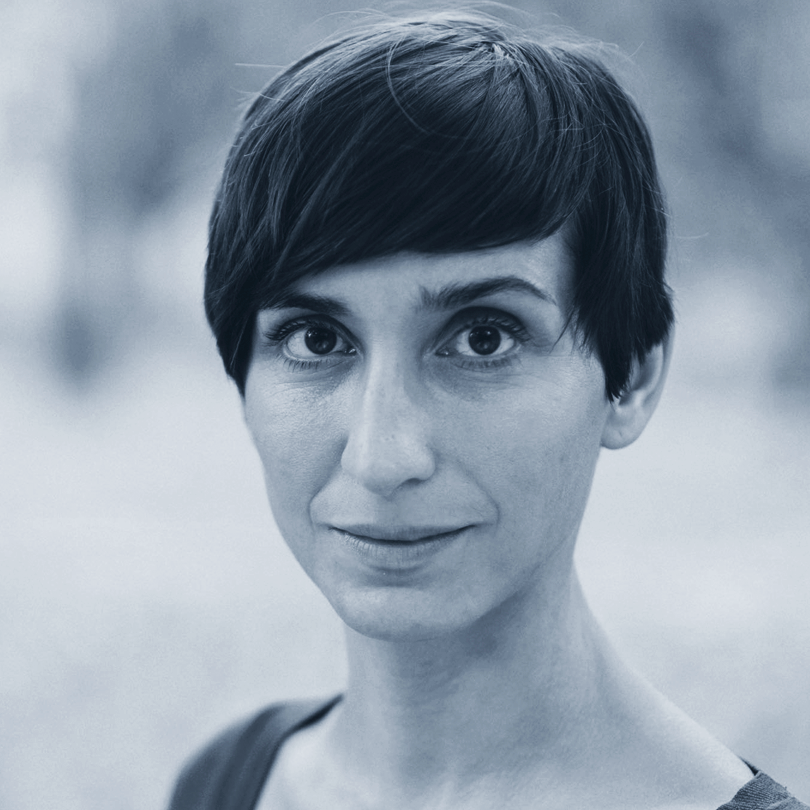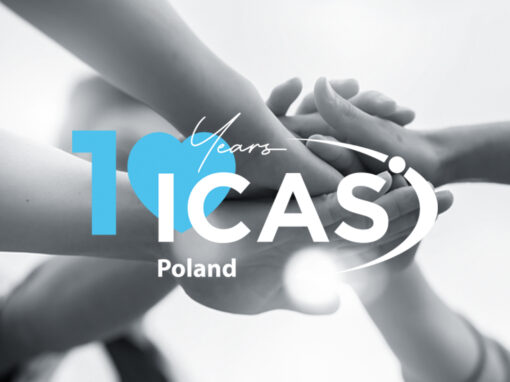Katarzyna Kowalska: Talking about death in a business context is rare or even non-existent. However, due to the pandemic, the topic has become more present in the lives of employees, managers, and teams. For a year now, we have seen the daily news headlines reporting the number of new deaths. How does this affect us?
Anja Franczak: The long-term effects are hard to predict at this point, but I believe they will be significant. The pandemic has made many people realize the fragility of our lives and health and how intertwined death is in our lives. If, for years, we managed not to think about it – except in situations when there was a tragedy – it now terrifies us even more. Avoidance is the biggest problem I see, as sooner or later, we will have to confront the topic of death and grief, both in our personal lives and at work. If we disconnect from it, we become utterly helpless when it eventually appears. In a professional context, I am regularly invited by various companies when an employee experiences a loss or grief, mainly to facilitate discussions within the team. This happens as part of the Employee Assistance Program (EAP) or outside it but only in crisis situations. I would like it to be part of general education because if we work in a larger organization, we can expect such situations to arise.
KK: I thought it was progress that companies are seeking support, and you’re suggesting that we should go a step further and act proactively.
AF: It is progress, and I’m always happy when this happens because it says a lot about the company’s culture. It shows that the management doesn’t consider grief solely a private matter that everyone has to deal with on their own but understands that it affects all aspects of life, including work. Grief is not just sadness; it has many work-related consequences, such as reduced concentration or memory disorders. I also think that these regular invitations to companies are linked to the current situation, and a few years ago, this would not have happened. I feel that the pandemic has heightened awareness and sensitivity to these important issues. How we support each other during these times is crucial.
KK: The pandemic has indeed accelerated many changes in companies, including a focus on the mental health of employees. There are many aspects to consider. Let’s start with how an individual who is grieving should behave when returning to work and what they can expect from their colleagues and bosses.
AF: It’s crucial to understand that we are all different, and each person reacts differently in crisis situations. We also have different ways of stabilizing ourselves – some people find comfort in talking, while others prefer silence, some withdraw, and others take action. So, it’s essential to be aware of what helps us and what adds to our stress. For many people, asking themselves this question is already a significant step. It’s not only about what has been shattered but also about what saves us during such times. The next step is to communicate this to your surroundings. This applies to the workplace as well: do we want one person (or a few people) with whom we can discuss our loss, or do we prefer work to be an escape from grief? For many people, this helps – since everything has changed at home and been turned upside down, they want work to remain the same, providing them with a sense of stability.
KK: We also need to tell others what helps us because they won’t know otherwise.
AF: You can’t find out without conversation and asking, “What do you need?” A common mistake, when on the other side, is trying to guess. Such attempts are usually based on our own needs. We assume that if something helps us, it will probably be beneficial for someone else as well, and this often leads to misunderstandings or even conflicts. Many questions arise within a team regarding how to treat the grieving person or how to talk to them. It’s essential to create an atmosphere where these questions can be asked. When I moderate team meetings, my main goal is to allow all fears and anxieties to be expressed, enabling each team member to voice their concerns. Often, it becomes evident that everyone is worried about the same things, which helps because we see that we’re not alone with the doubts running through our minds.
KK: What do team members say during these meetings?
AF: They often say that they don’t want to do anything that would make the grieving person feel worse. They want to avoid a situation where they say something, and the grieving person becomes sad. It’s crucial to understand that, regardless of our actions, this person thinks about their loss most of the time. Whatever we say or do won’t make them sad because they are already sad. Perhaps in these conversations, the sadness will manifest as tears or words, but it won’t be a result of our actions. It’s also about removing some of the pressure from ourselves.
KK: We also don’t want to ignore grief.
AF: Exactly. We fear that we’ll do something wrong, but the only thing that doesn’t help is pretending that nothing has happened. This often happens due to the fear of making a mistake. There’s a belief that we must find the right words, so if we’re not sure what to say, we choose silence. It can be very painful when the topic is all around, and everyone pretends that nothing has happened. This is the only danger I try to prevent: that helplessness doesn’t turn into silence, that we deal with it differently than through avoidance or escape, that we allow ourselves to acknowledge it more. We are powerless in the face of death, which contradicts our daily approach, especially in the workplace, where we are accustomed to a task-oriented approach that is effective – when there is a problem, we solve it and set a strategy. When we are confronted with grief and death, we touch the limits of our human power, what we have control over in our lives.
KK: I think this is the biggest disparity – in the business world, agency is a fundamental value, and suddenly, we have no agency. Yet, it happens.
AF: Yes, and it creates many challenges. That’s why I believe that basic education about the grief process is so crucial. There are many myths circulating about how grief lasts a year, and then everything should be fine, and if it lasts longer, it’s a sign that someone isn’t coping, and so on. This is not true. Many people have heard about very simplified models in which grief has five stages, and everyone has to go through all of them. These theories are now considered outdated. So, part of my work is psychoeducation to slightly change expectations of oneself and others.
KK: I remember the five stages of grief from my psychology studies.
AF: It’s interesting that mainly the theories from the 1960s are still in use in Polish universities. Sixty years have passed since then, and many modern models have been created to describe and understand grief.
KK: What characterizes these new approaches?
AF: They are dynamic, primarily. Old models depict grief as a linear process, with stages following one another. Even though they add that it doesn’t always have to look that way, these models create an impression in our minds that there are distinctive phases, and this proceeds in some predictable direction. Modern models describe the different components of grief in a way that they are fluid, one may dominate over another, or they may overlap. Each person develops a unique pattern at their own pace. This shows that we all have the same questions and issues, but each processes them in a completely different way and at an individual rhythm. It may take several years, and that’s normal. Rigid models often lead to people comparing their experience with the pattern and seeing a difference. It’s not that the theory is wrong, but they worry that there’s something wrong with them. One question I frequently hear when people describe their grief-related experiences is, “Is this normal?” When I use these new approaches, I see that it helps people.
KK: It changes a lot when we know that we don’t have to go through grief in a specific way or respond to it in a specific way. Sometimes, we imagine that there are correct statements or scripts suitable for the situation, and when a psychologist provides them, we’ll communicate well.
AF: That’s what I meant when I said we need to reduce the pressure. When participants are asked about their reflections after training, about what they have learned for themselves, I often hear, “Now I feel some relief.” That’s mainly what I aim for – to remove some of the pressure from this situation, introducing gentleness and tenderness, so our behavior is driven more by care and concern than the expectation of finding the right path.
KK: What does the work with a company seeking support look like? Is it done in groups or individually? What else is involved in the process besides education?
AF: Most often, it’s a group meeting, with a maximum of twelve people, and if the team is larger, it’s better to divide it. During these meetings, which usually last about two hours, I share theoretical information and knowledge, but, most importantly, I create a space for people to ask questions and express what’s difficult for them at that moment. I also encourage dialogue within the team because it’s often more important than the professional coming from the outside. Sometimes, managers decide to provide individual consultation to a specific person – not only the one who experienced the loss and is returning to work but also their immediate supervisor or the person working in the same room. However, the moderation of the team meeting is crucial.
KK: So, these are usually short-term interventions? We trust that the atmosphere will change, and people will prepare a bit, learn to talk, and will manage on their own?
AF: Yes, typically it’s one or two meetings. However, it’s worth considering basic workshops on the topic when there’s no crisis situation – maybe not for all employees, but for the management team. We absorb knowledge differently, and it’s much easier to talk about difficult issues when we’re not under the influence of strong emotions. This is a model I’m familiar with from Germany – my colleagues working there as grief companions regularly conduct “Introduction to Grief” sessions for HR teams in advance because they know this topic will arise.
KK: Speaking about the management team – should a manager prepare to treat a person experiencing grief differently?
AF: I believe so. It may not even be about treating that person with special attention, but it’s important to remember that grief is experienced by many people on a physical and mental level, leading to physical and cognitive limitations. As a result, the employee may not be able to work as they did before for some time. Thus, they may not be able to make significant decisions, for example. We also know that certain days in the year will be particularly difficult – the anniversary of the death or the deceased’s birthday. During those times, the employee may be in worse shape, so it’s better not to schedule essential events then. If we can periodically delegate some tasks to others or introduce flexible work hours – anything that supports the person – it will be helpful. In the long run, this will build a stronger relationship between the employee and the company. If my employer supports me during such a difficult time, I also identify more with the company’s work culture.
KK: This is a completely different dimension of leadership – showing personal sensitivity. There’s another situation when an employee commits suicide. Sometimes it’s related to work. How should we handle colleagues and the family of that person in such a situation?
AF: The grief process after suicide looks very similar, but there are issues that require much more space in this situation: it’s the issue of guilt and the entire area of interpreting what happened. One of our fundamental human needs is to understand why something happened. If we can’t understand it, we resort – even subconsciously – to various methods that help us in this regard. One of them is blaming – others or oneself. Guilt rarely concerns a specific mistake that someone made, but it serves a certain function: it helps us understand or demonstrate that we potentially had an influence.
KK: A sense of guilt provides the illusion of control.
AF: Exactly. That’s where we reach the limits of our power. Helplessness is so hard to bear that it’s easier to feel guilty than helpless. So, creating space for conversation in such cases is particularly important.
KK: I think we’re talking about grief, and there have been many positive aspects in our conversation. This topic can also be understood and openly discussed. Communication is a way to deal with helplessness.
AF: Yes, every time we share our helplessness with another person who also feels it, it helps a bit. Because this is something that connects us all. And this is entirely independent of our position in the company. That’s why small, human gestures that ignore the hierarchy in that particular moment are so crucial. For example, when a company decides to send a condolence letter to the family, it should not include a logo or a job title. This letter should ideally be handwritten to show that, in this situation, your position doesn’t matter, and we are dealing with something that brings us all down to the level of being human, where we are alone and helpless and support each other in that helplessness.
KK: And we don’t avoid what has no escape… Thank you very much for the conversation.
AF: Thank you as well, and I invite you to collaborate.









